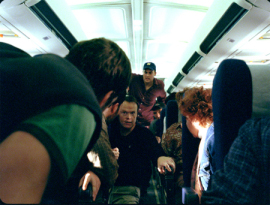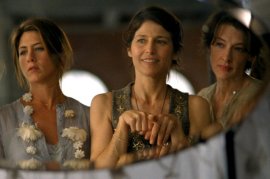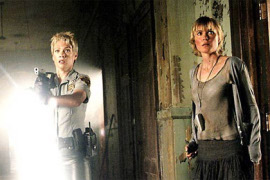 UNITED 93
UNITED 93
The question of whether it's too soon for United 93 is endlessly debatable. Yet United 93 we have. And having seen Paul Greengrass' dramatic re-creation of those shattering minutes aboard the doomed Newark-to-San Francisco flight on the morning of September 11, 2001, it seems that the timing of its release isn't just acceptable but - for this particular film, at any rate - absolutely essential.
Though the movie has been structured and shot with incredible elegance, there's nothing self-consciously, overtly "artistic" about Greengrass' work here; he presents the film's events in a straightforward, vérité style, and even denies us all expected, conventional narrative tropes. (There's no formal introduction to, or backstory behind, the characters, no obvious dramatic turning points ... there isn't even any resolution.) The movie isn't timid, but it has been written and directed with astonishing subtlety and care, and it has an immediacy that's both repellent and hypnotic. And, possibly, Greengrass could not have made United 93 as artlessly honest as it is had more years passed before he attempted it.
The film doesn't pretend to "understand" the events it shows, as future cinematic documents of 9/11 will no doubt attempt, and its themes aren't spelled out for the audience as they often are in, say, films about Vietnam and World War II; there's no benefit of hindsight for the filmmaker to latch on to in United 93, nothing that allows him to say, "This is what this tragedy meant to us." Greengrass honors the United 93 passengers by not inflating their heroism, or the horrors of their situation, in the slightest. The only melodrama in United 93 is that which you, yourself, bring to it; I was so caught up in the passengers' valiant struggle at the end that I was momentarily fooled into thinking that history might perhaps rewrite itself, and the plane would land safely.
Of course, it didn't. Yet the effect that awareness has on the film is unexpected. Rather than making United 93 feel relentlessly grim, our knowledge of the outcome makes the heroic attempts of the passengers all the more moving; you leave the theatre shaken, sickened, and filled with admiration for a group of people who looked death in the eye and said, "No." (Unlike many of my fellow audience members, I held it together pretty well during the screening, but broke down for several minutes once I was in the car.) Watching United 93 hurts, as it should, and it might take another week - and maybe another viewing - for me to fully grasp its impact. At this point, however, and regardless whether it's "too soon," I can't imagine how the film could possibly be any better.
 FRIENDS WITH MONEY
FRIENDS WITH MONEY
Nicole Holofcener's Friends with Money is a slight, nearly plotless work, but so beautifully observed, shrewdly written, and humanely funny that it's nearly exhilarating. Centering around a quartet of Californians - three with cash (Catherine Keener, Frances McDormand, Joan Cusack), one without (Jennifer Aniston) - as they deal with the messy complications of their lives, the characters' individuality continually pokes through the surface of their "stock" romantic and financial woes; these women may seem like types, but as writer/director Holofcener has conceived them, they're incredibly specific. Her characters (and not just the leads) are so well-constructed that you feel you've known them forever, yet it becomes clear that - on screen at least - you've never encountered anyone like them before. Friend with Money's originality lies in Holofcener's sharp eye and readiness with a perfect, telling detail - McDormand's depressed Jane explains her unwillingness to wash her hair with a plaintive, heartbreaking "I get tired when I lift my arms" - and her inspired cast performs with beguiling, good-humored naturalism.
At least most of them do. Aniston, however, doesn't bring anything fresh to her role. Her line readings lack surprise, and her one-dimensional mopey-ness quickly becomes a drain on the movie; basically, she comes across as a vaguely miserable movie star. (Which, to be fair, she may have been during filming.) Yet despite having Friends with Money's focal role, she's easy enough to forget about. Keener, whose character hesitantly stumbles toward self-realization, is sharp and focused, giving her readings lovely undercurrents of sadness. Her opposite number, Cusack, is playing a fundamentally happy woman, and it's a good fit for the actress - her eccentric normalcy occasionally lends the film a giddy rush. And McDormand is not only peerlessly funny - as Jane's temperamental high dudgeon increases, so does the number of laughs she generates - but gloriously nuanced; her final shot in the film, looking at her (probably) gay husband with enormous affection, is as subtle, and touching, a character reveal as you could ask for. Friends with Money is limited in scope but rich in character and humor, and its speedy wrap-up feels just right - true friends know how to not overstay their welcome.
 SILENT HILL
SILENT HILL
Silent Hill isn't nearly silent enough. Whenever director Christophe Gans is allowed to sustain a mood of eerie quiet, this horror yarn (based on the series of popular video games) is actually quite spectacular, and its first reel is especially fine. Gans' overhead shots are remarkably well-composed; the images of a motorcyclist chasing a speeding car through the West Virginia mountains are haunting, and when our heroine (Radha Mitchell) finds herself wandering through Silent Hill's ghost town in search of her daughter (Jodelle Ferland) - ashes raining from the sky and mutating beasties barely visible through the fog - the movie casts a creepy spell. The director is also terrific with light, shadow, and sound, and pulls off some exquisitely gruesome effects; even die-hard horror-flick aficionados may wince when one of the CGI meanies (who appears to have a ball-peen hammer for a head) grabs a woman, tears the flesh off her body in one lightning-quick motion, and whips the carcass against a church door with a nauseating splat.
Much of Gans' work is admirable, and even impressive. But why, oh why, do those populating the film have to talk? Every time the movie tries to explain its storyline or establish its characters' motivations, Silent Hill borders on the laughable. Roger Avary's grave, portentous script, with its leaden dialogue, veers off onto so many tangents that the results are bizarre to the point of incoherence, but this wouldn't be so problematic if the movie didn't revel in its deadly serious twists; it feels like the first video-game adaptation hoping to score a Best Picture nod. Perfectly fine actors such as Mitchell, Sean Bean, Deborah Kara Unger, and the great, suggestively nasty Alice Krige recite fourth-rate banalities and try to convince you that Silent Hill will eventually make some sort of sense, but nothing in it ever does, and the climax is a real botch - Joan of Arc meets John Carpenter's The Thing meets The Others. With barbed wire. Don't ask. Silent Hill is visually stunning but dopey enough to turn your brain to gelatin - it might best be enjoyed on DVD with the sound (and subtitles) turned off.










